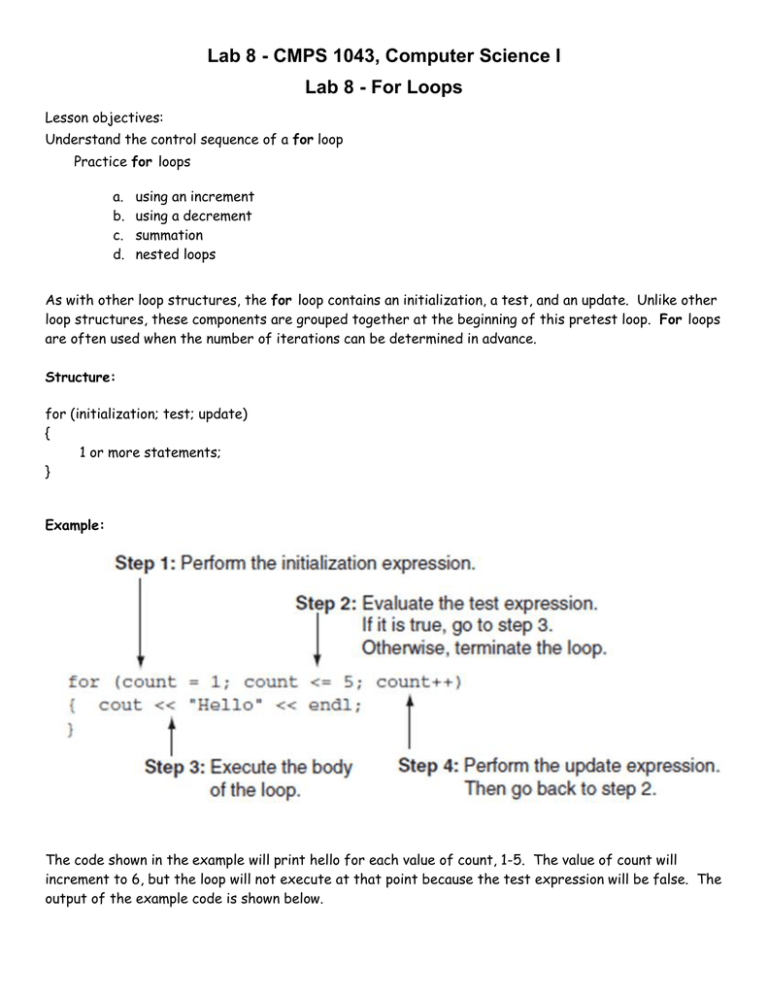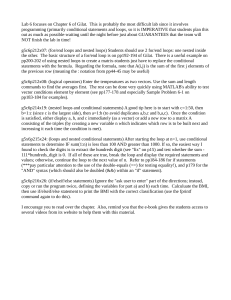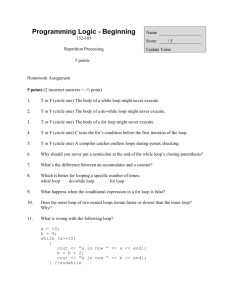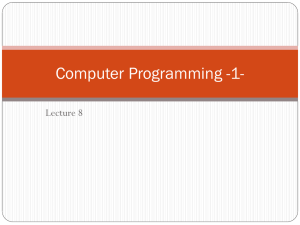Lab 8 - CMPS 1043, Computer Science I
advertisement

Lab 8 - CMPS 1043, Computer Science I
Lab 8 - For Loops
Lesson objectives:
Understand the control sequence of a for loop
Practice for loops
a.
b.
c.
d.
using an increment
using a decrement
summation
nested loops
As with other loop structures, the for loop contains an initialization, a test, and an update. Unlike other
loop structures, these components are grouped together at the beginning of this pretest loop. For loops
are often used when the number of iterations can be determined in advance.
Structure:
for (initialization; test; update)
{
1 or more statements;
}
Example:
The code shown in the example will print hello for each value of count, 1-5. The value of count will
increment to 6, but the loop will not execute at that point because the test expression will be false. The
output of the example code is shown below.
Hello
Hello
Hello
Hello
Hello
The update in a for loop can be either an increment or a decrement. It is important to make sure that
the test corresponds with the update.
Type in the following code:
#include<iostream>
using namespace std;
int main( )
{
int count;
for (count = 1; count <= 5; count++)
cout << count << endl;
system("pause");
// keeps DOS screen open until a key is pressed
return 0;
}
1. What is the output of the above code?
2. What happens if the update is changed to count-- ? Why?
3. Modify the code above so that the numbers are printed in reverse order.
The update can be incremented/decremented by more than one. For example, count+=2 will cause count
to increment by two rather than one.
4. Modify the code to print all of the even numbers from 2 to 100.
5. Modify the code to print: 10 20 30 40 50 60 70 80 90 100
An accumulator can be used with a for loop to keep a running total of a value. For example, the code
below will add all of the numbers from 1 to 100.
#include<iostream>
using namespace std;
int main( )
{
int count, sum;
sum = 0;
for (count = 1; count <= 100; count++)
sum += count;
cout << "The sum of the numbers from 1-100 is " << sum << endl;
system("pause");
// keeps DOS screen open until a key is pressed
return 0;
}
6. Type in and run the code above. What is the output?
The term nested loops means that one loop is completely inside another. When nested loops are used,
the inner loop goes through all its repetitions for each iteration of the outer loop. The total number of
repetitions for an inner loop is the product of the number of repetitions of the two (or more) loops. The
code below illustrates a nested for loop which prints a 5 X 4 table where each table entry represents
the appropriate row number.
#include<iostream>
#include<iomanip>
using namespace std;
int main( )
{
int r, c;
for (r = 1; r <= 5; r++)
{
for (c = 1; c <=4; c++)
cout << setw(3) << r;
cout << endl;
}
system("pause");
return 0;
// keeps DOS screen open until a key is pressed
}
7. Type in and run the code above. Modify the code so that it prints the column number rather than the
row number.
Assignment
Modify the last program to include the following.
1. Add header of comments containing required information (as specified in the previous
labs). Add at least 3 comments in the body of the program.
2. Print a 10 X 10 table in which each entry in the table is the sum of the row and column
number.
3. Include an accumulator that will calculate the sum of all the table entries. Print the sum
outside of the nested loop along with an appropriate output statement.
4. When the program is working correctly, change all cout statements to statements that
will print to a file, as you learned in an earlier lab. Print out both the program code and
the output file to turn in no later than next week. SAVE your work before leaving the
lab.







